How To Speed Up Wifi Connection On Pc App
On Windows 10, the "Remote Desktop" app is available through the Microsoft Store, and it's been designed to make it easier to connect and control other devices over the local network or internet. It's also the experience that is meant to replace the built-in legacy "Remote Desktop Connection" feature.
The app is straightforward, but depending on how you need to connect, the app is only one piece of the puzzle, since you must also configure additional settings and forward the appropriate port in the router to successfully connect to other Windows 10 devices remotely. Also, there's a caveat. Although you can install the Remote Desktop app on any version on Windows 10, the remote desktop protocol that allows connections to a device is only available on Windows 10 Pro and business variants of the OS. Windows 10 Home doesn't allow remote connections.
In this Windows 10 guide, we'll walk you through the steps to allow remote connections from within the local network or internet, and the steps to use the Remote Desktop app to start a session remotely.
How to allow remote connections on Windows 10
The Remote Desktop app is easy to use to connect to other devices. However, the configuration you need will depend on whether you're trying to connect in the local network or through the internet.
Enable remote connections on Windows 10
When trying to start a remote connection from within the local area network (LAN), you only need to make sure the computer you're trying to access has the option to allow remote desktop connections enabled.
Control Panel
To enable remote connections on Windows 10, use these steps:
- Open Control Panel.
- Click on System and Security.
-
Under the "System" section, click the Allow remote access option..
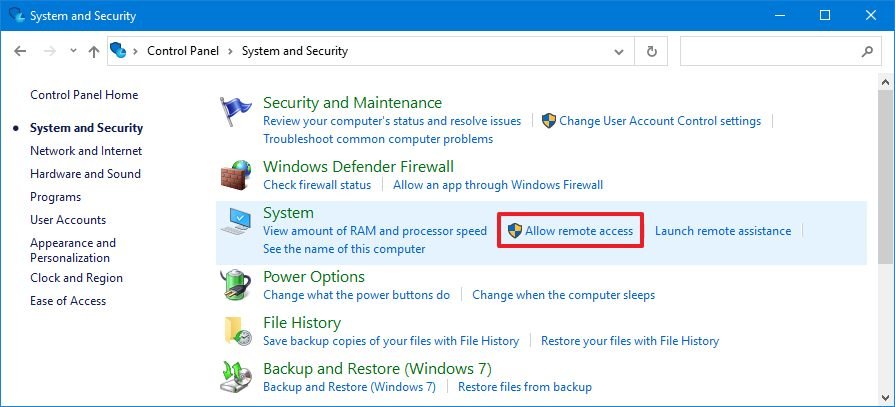 Source: Windows Central
Source: Windows Central - Click the Remote tab.
-
Under the "Remote Desktop" section, check the Allow remote connections to this computer option.
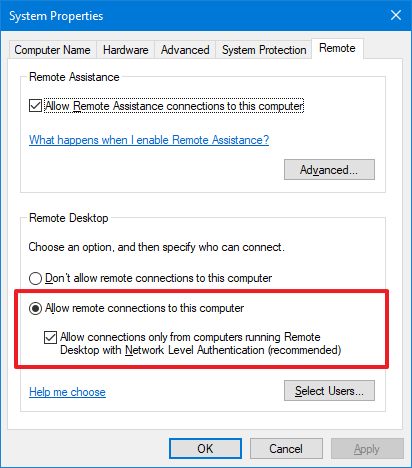 Source: Windows Central
Source: Windows Central - Check the Allow connections only from computers running Remote Desktop with Network Level Authentication option.
- Click the OK button.
- Click the Apply button.
- Click the OK button.
Once you complete the steps, remote desktop connections will be allowed on the device. Windows 10 will even add the necessary rules in the built-in Microsoft Defender Firewall, but you may need to configure the rules manually if you have a third-party firewall.
Settings app
You can also enable the Remote Desktop feature using the Settings app with these steps:
- Open Settings.
- Click on System.
- Click on Remote Desktop.
-
Turn on the Enable Remote Desktop toggle switch.
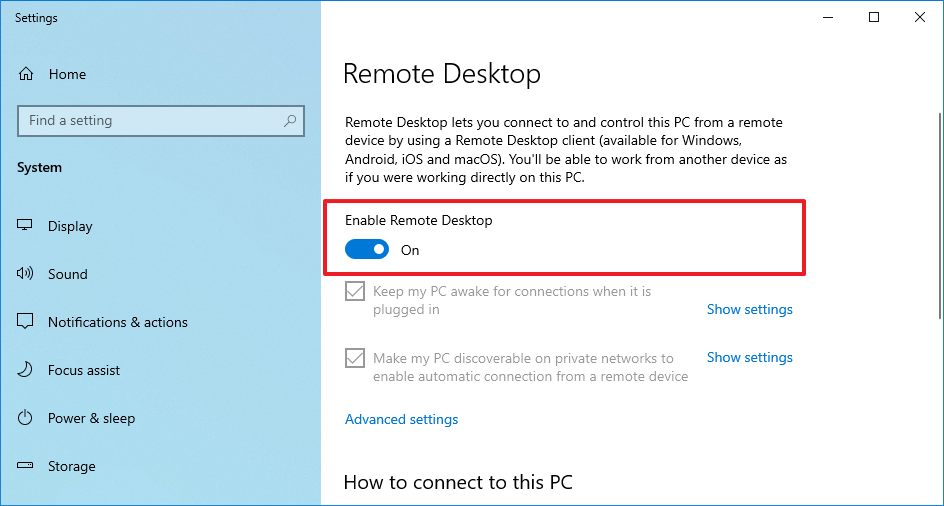 Source: Windows Central
Source: Windows Central - Click the Confirm button.
If you're setting up a remote desktop using an internet connection, continue with the steps below. If you're trying to connect to another device within the local network, you can skip to the steps below, and continue with the start a remote desktop connection instructions.
Enable remote connections on router
If you have to access the computer over the internet, you will also have to configure the router (modem) to allow the remote connection. A process that also requires knowing the public address to contact the remote computer.
Configure static IP address on Windows 10
Computers usually get assigned dynamic IP addresses from the DHCP server (router), which means they can always change. If you plan to use remote desktop often, you may want to configure a static IP address to avoid reconfiguring port forwarding on the router when the computer gets a new address.
Control Panel
To set a permanent IP address configuration, use these steps:
- Open Control Panel.
- Click on Network and Internet.
-
Click on Network and Sharing Center.
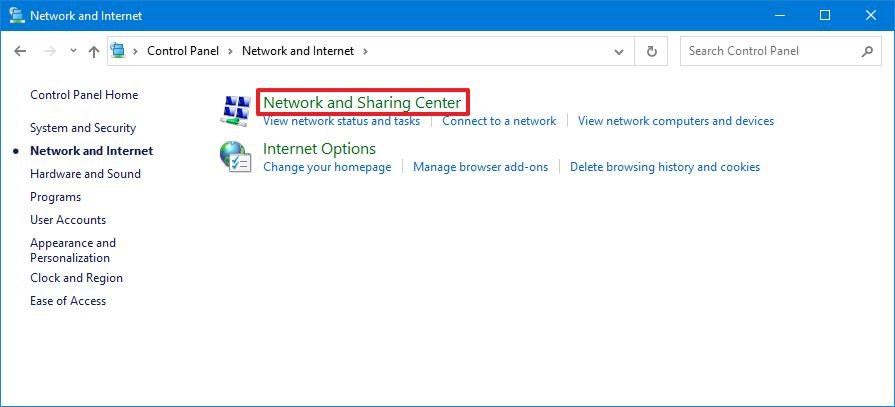 Source: Windows Central
Source: Windows Central -
Click the Change adapter settings option from the left navigation pane.
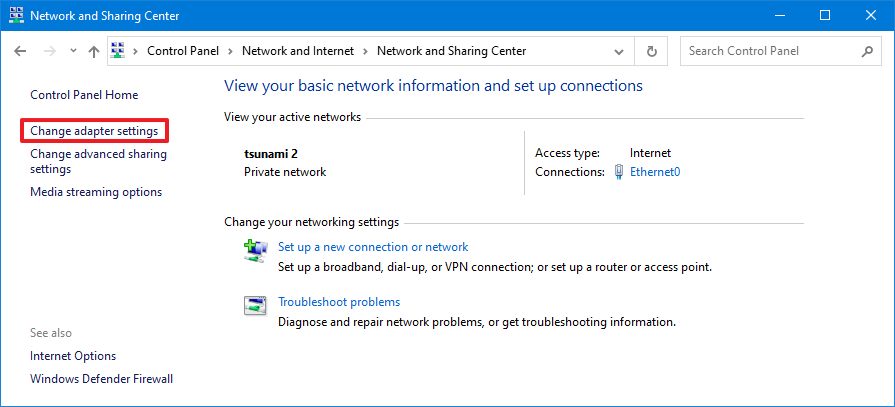 Source: Windows Central
Source: Windows Central -
Right-click the active adapter and select the Properties option.
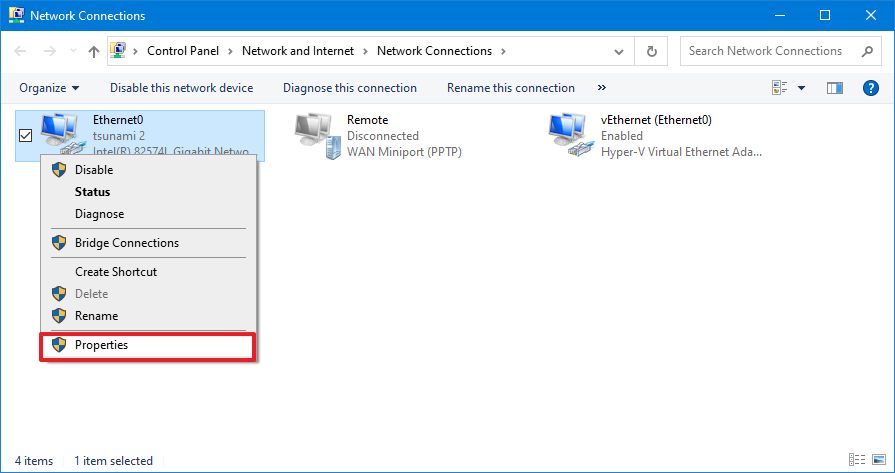 Source: Windows Central
Source: Windows Central - Select the Internet Protocol Version 4 (TCP/IPv4) option.
-
Click the Properties button.
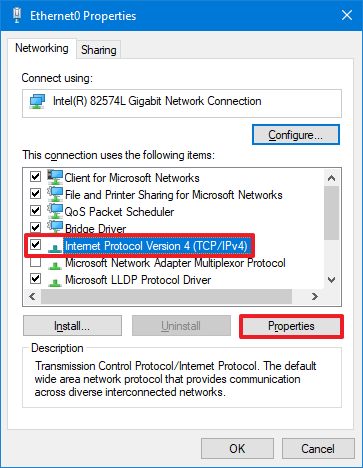 Source: Windows Central
Source: Windows Central - Click the General tab.
- Select the Use the following IP address option.
-
Specify a valid local IP address outside the local DHCP scope to prevent address conflicts. For example, 10.1.4.201.
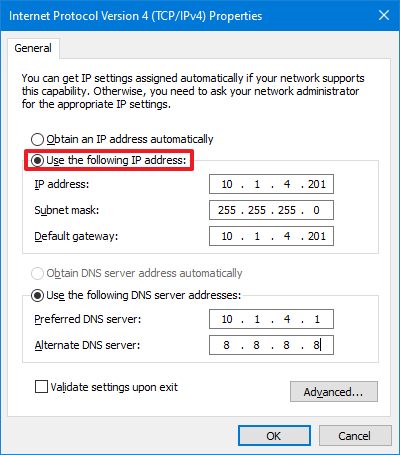 Source: Windows Central
Source: Windows Central Quick tip: Typically, you'll find this information on the router inside the DHCP settings section. The routers' interface is always different per manufacturer, which means that you may need to consult your manufacturer support website for more specific details. If you're unsure of the configuration you have to use, you can use your current TCP/IP configuration as a reference, which you can find running the
ipconfig /allcommand in Command Prompt. - Specify a subnet mask for the network (for example, 255.255.255.0), but the system usually fills this infomration for you based on the "IP address" you entered earlier.
- Specify the default gateway address, which is the router's address—for example, 10.1.4.1.
-
Under the "Use the following DNS server addresses" section, in the "Preferred DNS server" field, specify the IP address of your DNS server, which in most cases is also the address of the router —for example, 10.1.4.1.
Quick tip: If you can't connect to the internet, you may also want to try using one of the Google Public DNS addresses (such as 8.8.8.8) for the "Alternate DNS server" option.
- Click the OK button.
- Click the Close button.
After you complete the steps, the new network configuration will apply, and the IP settings will never change.
Some routers include a feature to make the current TCP/IP configuration static. If you want to use this option instead, you can consult your manufacturer support website for specific steps on how to complete this task.
Determine network public IP address
You'll also need the remote network's public IP address to contact the device over the internet.
To find the IP address assigned by the Internet Service Provider (ISP), use these steps:
- Open web browser.
- Visit Bing.com or Google.com.
- Search for "What's my IP."
-
Confirm your public IP address in the first result.
 Source: Windows Central
Source: Windows Central
Usually, for residential customers, internet providers also offer dynamic public IP addresses, which means that your public IP address may change from time to time.
If you need a more reliable solution, there are "Dynamic Domain Name System" (DDNS) services (such as DynDNS, OpenDNS, No-IP, Asus.com (for Asus routers)), which can track the public IP changes. Alternatively, you can also contact your ISP to request a static IP address, but it might costs you additional since this is typically a feature reserved for business.
Forward port on router
You must also forward the TCP port 3389 on the router to allow a remote connection over the internet to the computer in the local network.
Quick note: The interface to change the router settings are different per manufacturer, and sometimes even per model. However, you can use the following instructions as a reference to configure your router. You can always check the manufacturer support website for more specific details.
To forward a port on your router, use these steps:
- Open Start.
- Search for Command Prompt and click the top result to open the console.
-
Type the following command to view the current TCP/IP configuration and press Enter:
ipconfig - Under the "IPv4 Address" field, confirm the device address. For example, 10.1.4.100.
-
Under the "Default Gateway" field, confirm the device gateway address (the router address)—for example, 10.1.4.1.
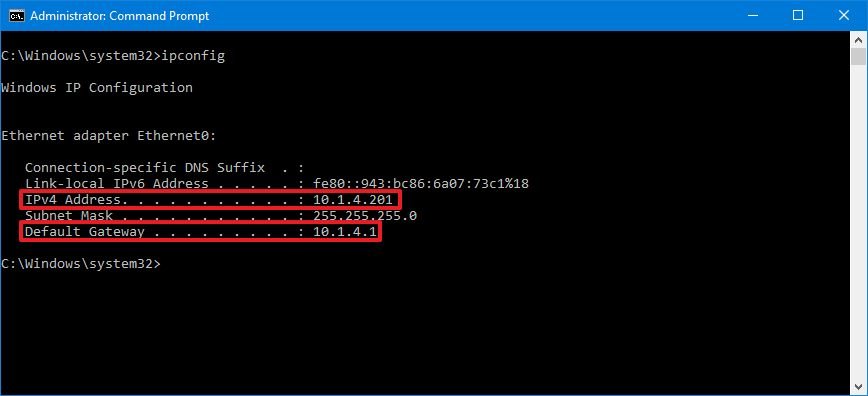 Source: Windows Central
Source: Windows Central - Open web browser.
- Type the IP address of the router (Default Gateway) in the address bar and press Enter.
-
Sign in to the router using the correct username and password.
Quick tip: If you have never done this, and you are using the router provided by the ISP, you can find the information on a sticker attached to the device.
- Browse to the Port Forwarding settings page.
- Confirm that the Port Forwarding service is enabled (if applicable).
-
Under the port forwarding list, click (in this case) the Add profile button.
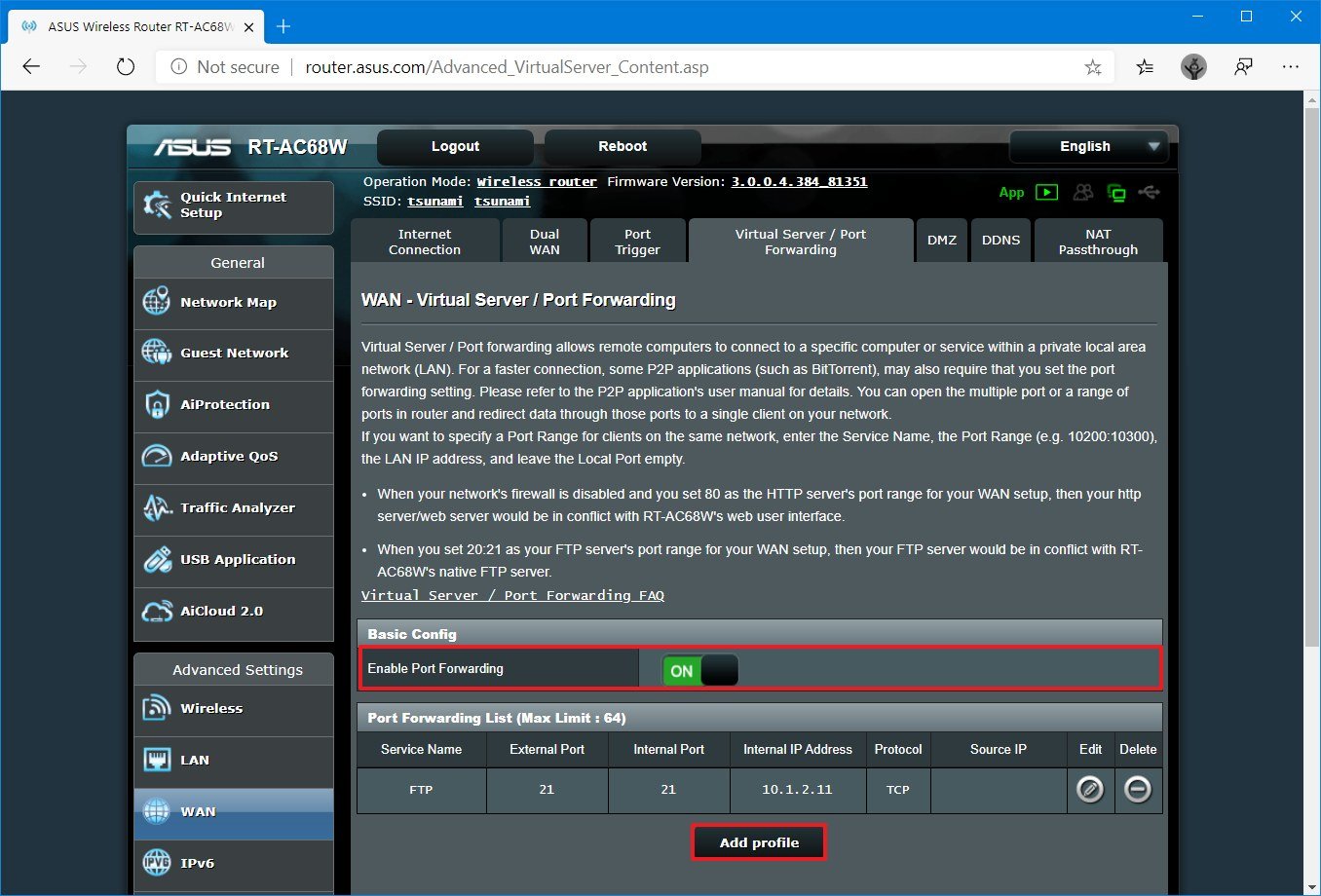 Source: Windows Central
Source: Windows Central -
Create a new port forward with the required information. For example:
- Service name: Specify the reference name for the service. For instance, OfficePC Remote (optional).
- Protocol: TCP.
- External Port: 3389.
- Internal Port: 3389.
- Internal IP Address: Specify the IP address of the computer you're trying to connect. For instance, 10.1.4.100
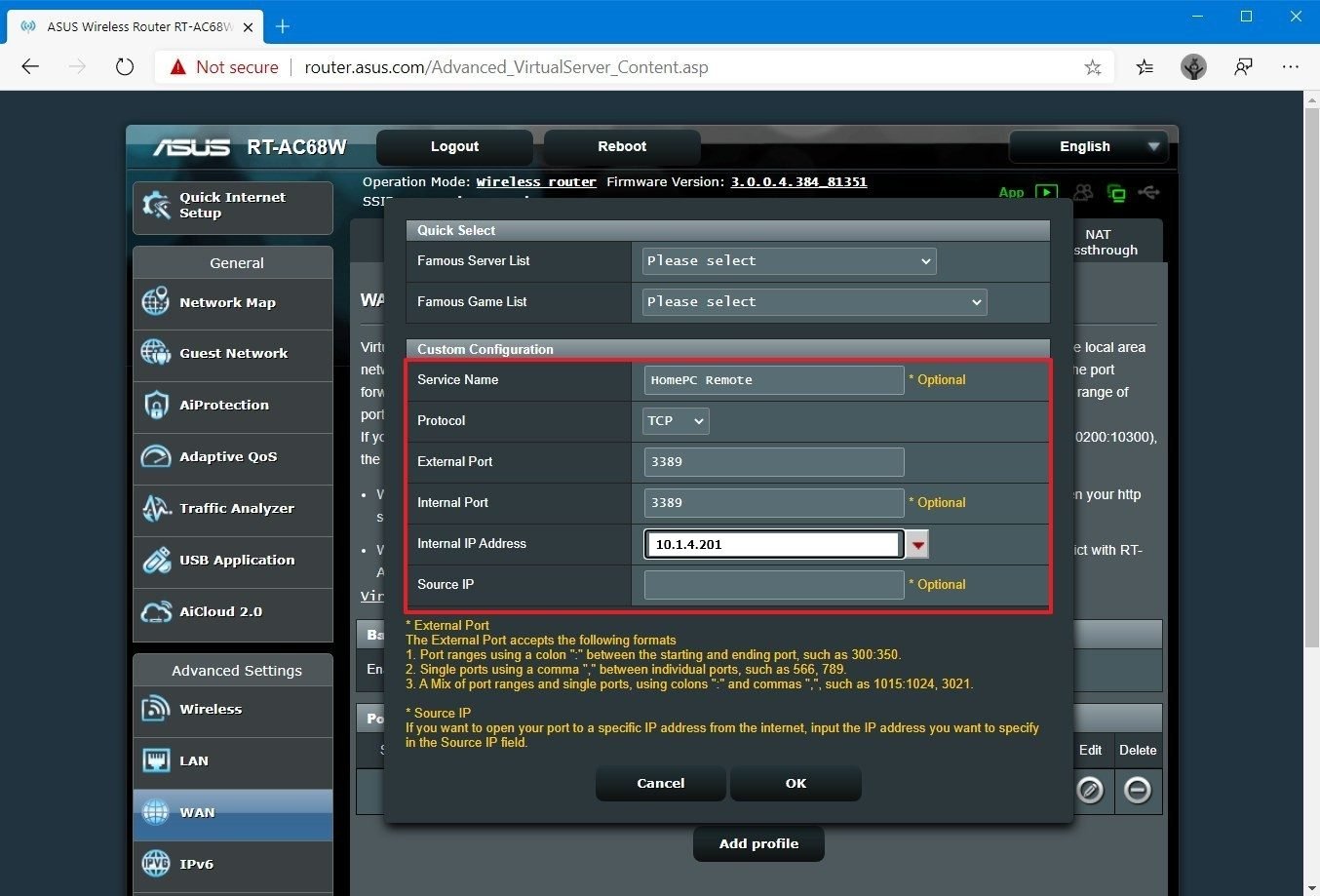 Source: Windows Central
Source: Windows Central - Click the OK button.
Once you complete the steps, the port will open on the router, allowing remote desktop connections through the internet to that specific computer.
How to establish remote desktop connection on Windows 10
After setting up the computer and router, you can initiate a remote connection using the Remote Desktop app on Windows 10.
Install Remote Desktop app
If you don't have the modern version of the Remote Desktop app, you'll need to install it from the Microsoft Store with these steps:
- Open Microsoft Remote Desktop app page.
- Click the Get (or Install) button.
- Click the Open Microsoft Store button.
-
Click the Get (or Install) button.
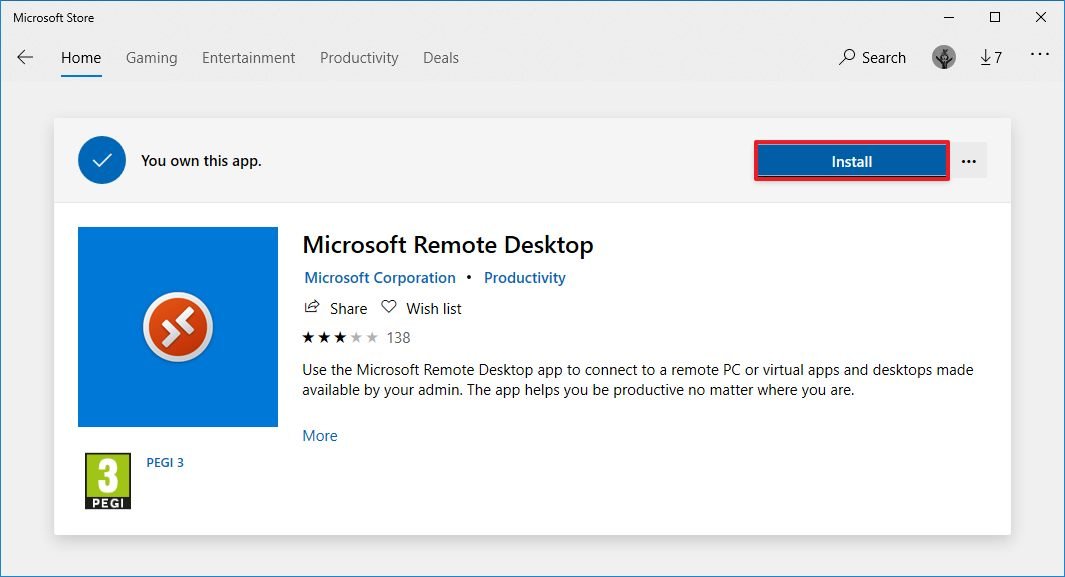 Source: Windows Central
Source: Windows Central
Once you complete the steps, you can launch the app from within the Microsoft Store or Start menu. If the app isn't working correctly, or you want to try upcoming improvements and features, you can always download the preview version of the app.
Start remote desktop connection
To connect to a computer remotely, use these steps:
- Open Remote Desktop app.
- Click the + Add button in the top right.
-
Click the PCs option.
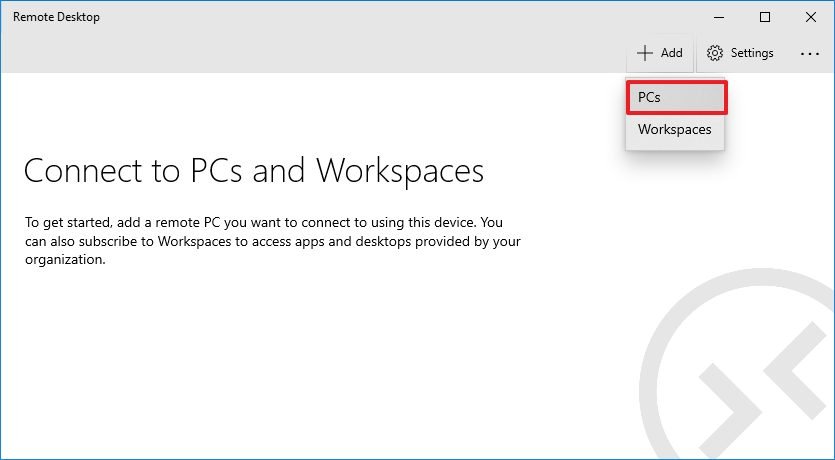 Source: Windows Central
Source: Windows Central -
Under the "PC name" section, specify the TCP/IP address of the computer you're trying to connect:
- If the device is inside a private network, then enter the local IP address.
- If the device is in a remote network (via the internet), enter the public IP address.
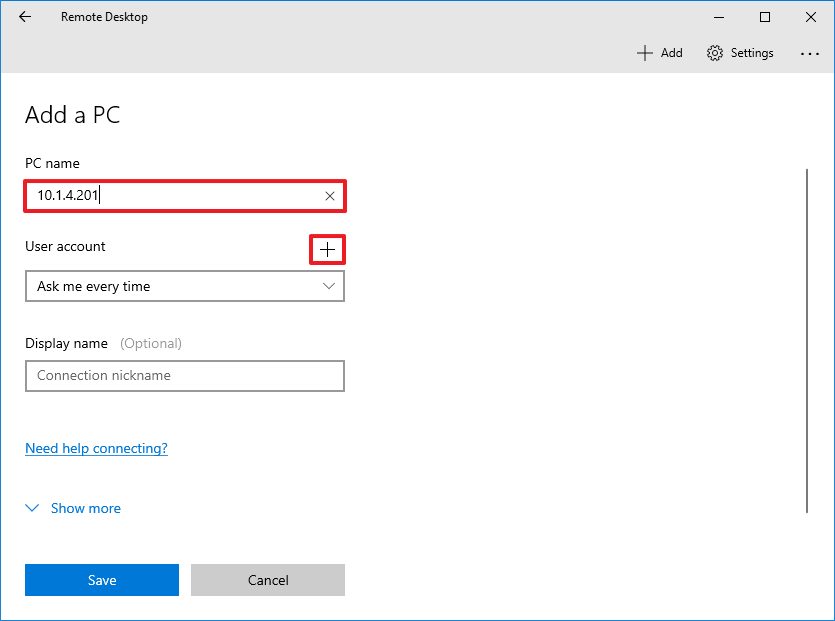 Source: Windows Central
Source: Windows Central - Under the "User account" section, click the + (plus) button in the top-right.
-
Confirm the account information to sign in to the remote computer:
- If the remote device is using a Microsoft account, then enter that Microsoft account sign-in information.
- If the remote device uses a local account, enter the local username and password to sign-in.
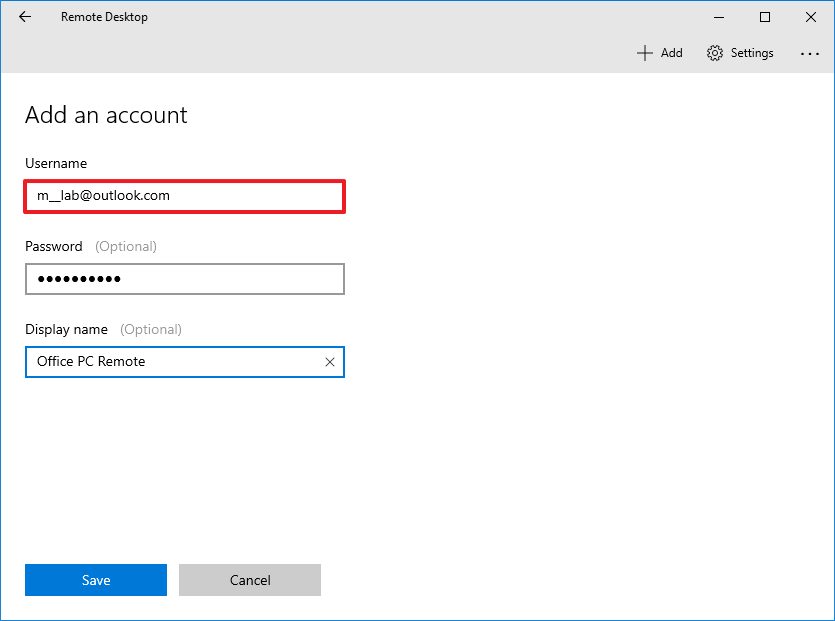 Source: Windows Central
Source: Windows Central - (Optional) Under the "Display name" section, specify the account settings' name.
- Click the Save button.
- (Optional) Under the "Display name" section, specify the connection's name, for example, Office PC Remote.
-
Click the Show more option.
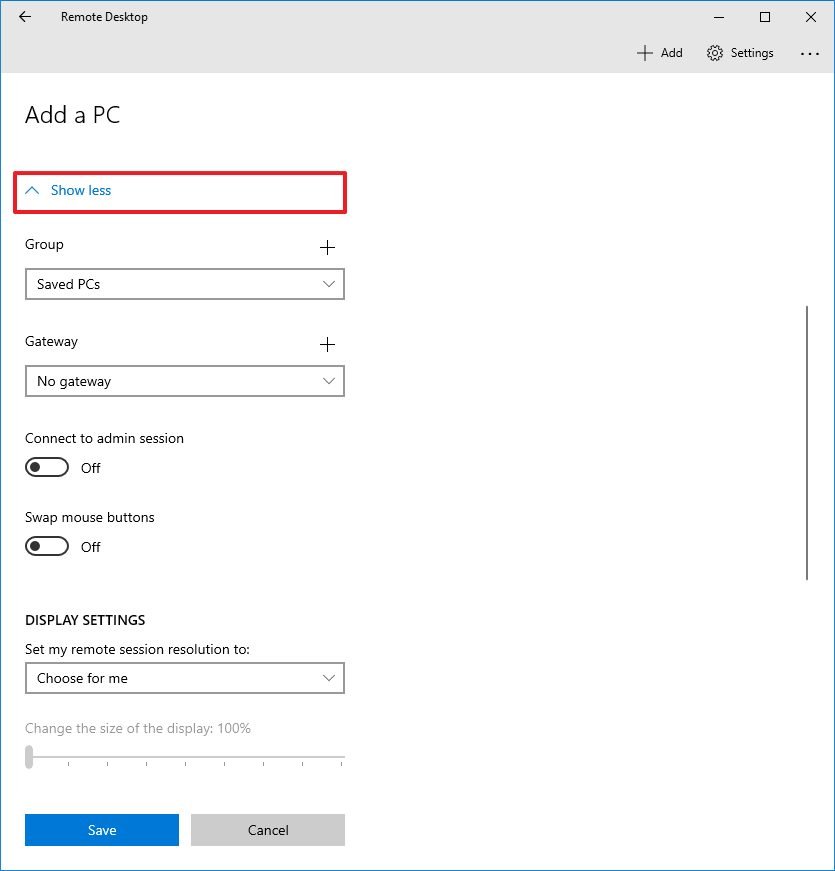 Source: Windows Central
Source: Windows Central -
(Optional) Select additional settings as necessary.
Quick tip: The additional settings include the option to connect using an admin session, set the remote session resolution, and clipboard, among others. Usually, you don't need to configure these options, and you should only use them depending on the scenario.
- Click the Save button.
-
Under the "Saved Desktops" section, click the connection to start a remote session.
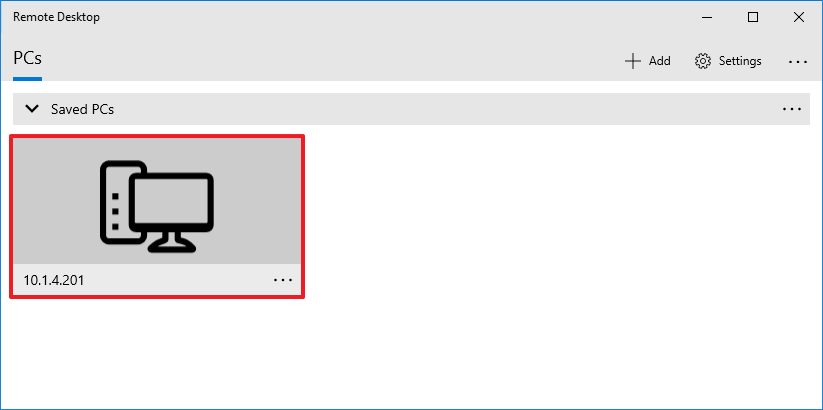 Source: Windows Central
Source: Windows Central - Check the Don't ask about this certificate again option (if applicable).
- Click the Connect button.
After you complete the steps, if you configured everything correctly, you should now be able to connect to the Windows 10 device.
To terminate the session, you can close the window or click the three-dotted menu button from the top-middle, and then click the Disconnect button.
Change app and connection settings
The Remote Desktop app also allows you to customize various settings of the experience.
Change general settings
The Remote Desktop app comes with a settings page to change some configurations options or correct account settings.
To change general settings, use these steps:
- Open Remote Desktop app.
- Click the Settings button in the top-right.
- Select the user account from the list.
-
Click the Edit (pen) button to adjust the settings.
 Source: Windows Central
Source: Windows Central -
Click the Save button.
 Source: Windows Central
Source: Windows Central
Using these settings, you can also prevision additional user accounts (with the plus + button) that you can later use to connect to other devices or as a different user.
The Gateway option allows you to set a gateway server, but you'll rarely need to use this option. Also, the Group option allows you to group saved connections into different groups. Although you're likely never going to use this feature, it's a handy option to organize multiple devices connections.
Change session settings
To change the session settings for Remote Desktop, use these steps:
- Open Remote Desktop app.
-
Click the Settings button in the top-right.
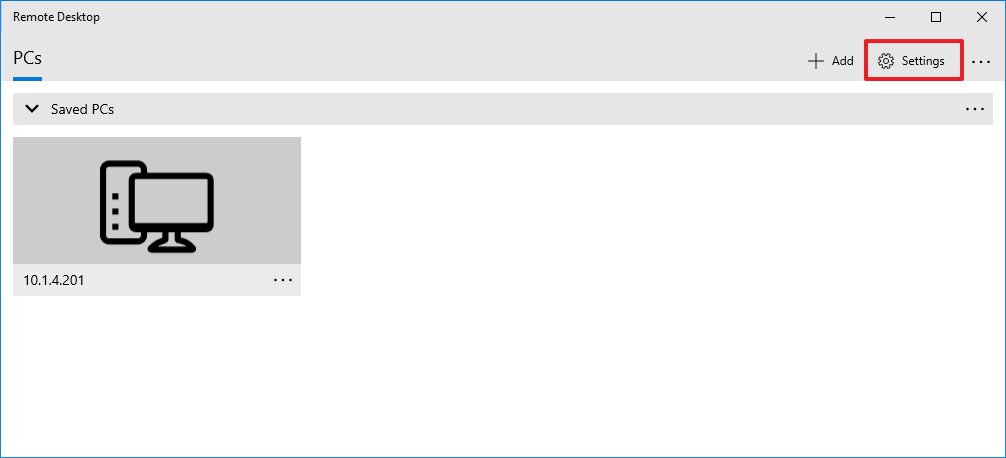 Source: Windows Central
Source: Windows Central - Turn on or off the Start connections in full screen toggle switch.
- Turn on of off the Start each connection in a new window toggle switch.
-
Use the When resizing the app drop-down menu to decide how the remote desktop should look when resizing the Remote Desktop app. Options available, include:
- Stretch the content, preserving aspect ratio (recommended).
- Stretch the content.
- Show scroll bar.
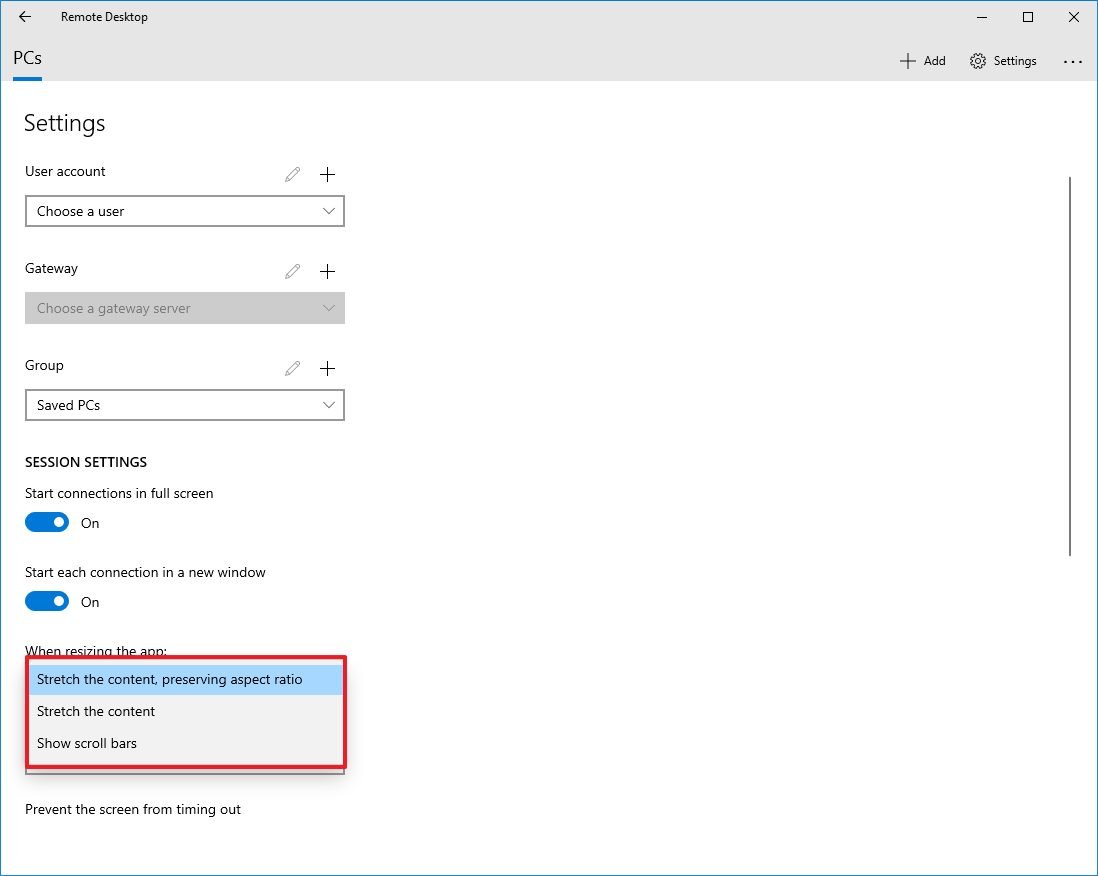 Source: Windows Central
Source: Windows Central -
Use the "Use keyboard command with a" drop-down menu to decide whether shortcuts (such as Ctrl + C) work only locally or on the remote desktop. Options available, include:
- My local PC only.
- My remote session when it's in full screen (recommended).
- My remote session when it's in use.
- (Optional) Turn on the Prevent the screen from timing out toggle switch.
Alongside editing the account and session settings, you can also enable the option to show a preview of the remote desktop in the connection, which adds a visual queue to make it easier to find the correct connection.
Change connection settings
To edit the settings of a remote connection, use these steps:
- Open Remote Desktop app.
-
In the saved desktop, click the menu (three-dotted) button and select the Edit option.
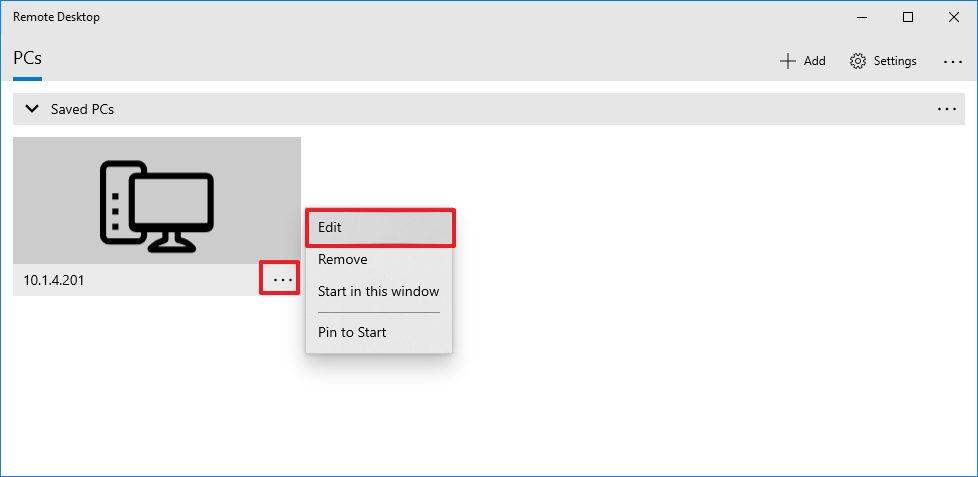 Source: Windows Central
Source: Windows Central -
Change the computer name, account, and settings as needed.
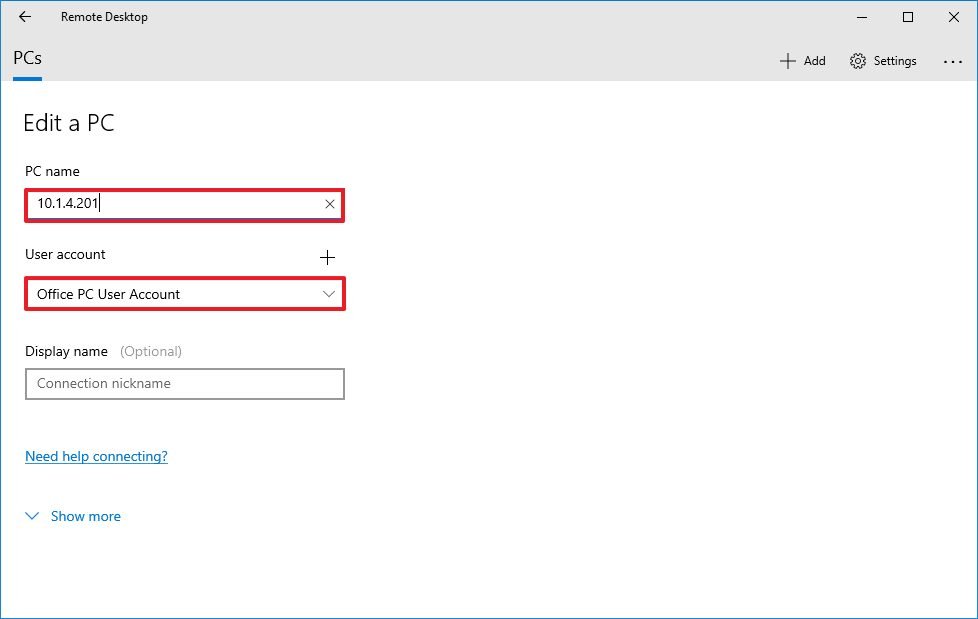 Source: Windows Central
Source: Windows Central - In the saved desktop, click the the menu (three-dotted) button, and select the Remove option to delete the connection.
- Click the the menu (three-dotted) button, and select the Pin to Start option to show a direct link to connection in the Start menu.
Once you complete the steps, the settings will save and apply automatically.
How to troubleshoot remote desktop connection on Windows 10
The Remote Desktop app usually works without issues, but if you have followed all the steps and can't connect, you will need to troubleshoot the problem.
Confirm firewall settings
Windows 10 should automatically open the required firewall ports when you enable remote desktop, but it might not always be the case. If the connection is failing, make sure that the firewall is allowing the Remote Desktop service.
To enable remote desktop through the firewall, use these steps:
- Open Windows Security app.
- Click on Firewall & network protection.
-
Click the Allow an app through firewall option.
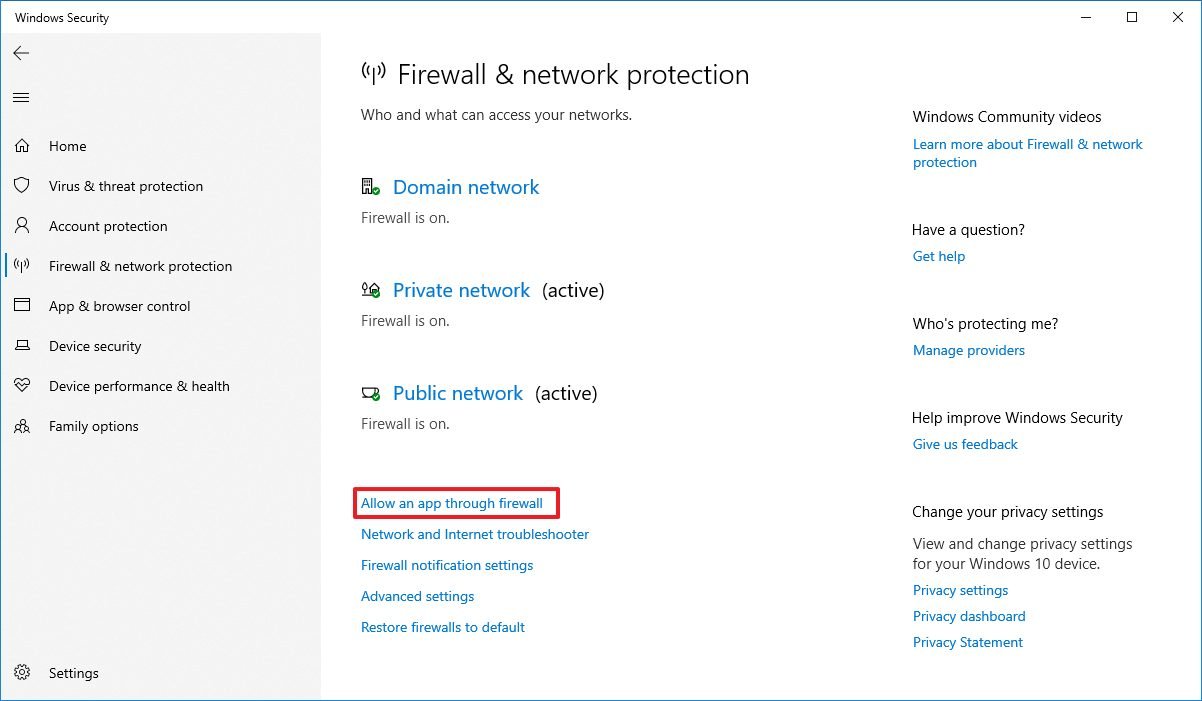 Source: Windows Central
Source: Windows Central - Click the Change settings button.
-
Check the Remote Desktop option and check the options for Private and Public.
 Source: Windows Central
Source: Windows Central - Click the OK button.
If you're using a third-party firewall or antivirus, you may want to disable these applications to see if you can connect. However, you may need to check the software support website for more specific details.
Unblock remote connection port
If the settings are configured correctly, and you still can connect, there's a chance the internet provider is blocking the remote desktop port for security reasons. If this is the case, you may want to contact the ISP directly to resolve the issue.
Use IP address, not the PC name
When using the Remote Desktop app, it's better to use the device's IP address instead of the computer name. Otherwise, you may stumble upon some issues.
Also, when adding a new device, make sure to enter the appropriate IP address (as shown in the above steps). For example, use the local IP address to connect remotely from within the private network, or use the public IP address to connect over the internet.
Confirm remote desktop service
It's also possible that you may not be able to connect because the required services are not running on Windows 10.
To determine if the remote desktop service is running, use these steps:
- Open Start.
- Search for Services and click the top result open the console.
- Select the Remote Desktop Service and check the "Status" column reads Running.
-
If it's not running, right-click the service and select the Start option.
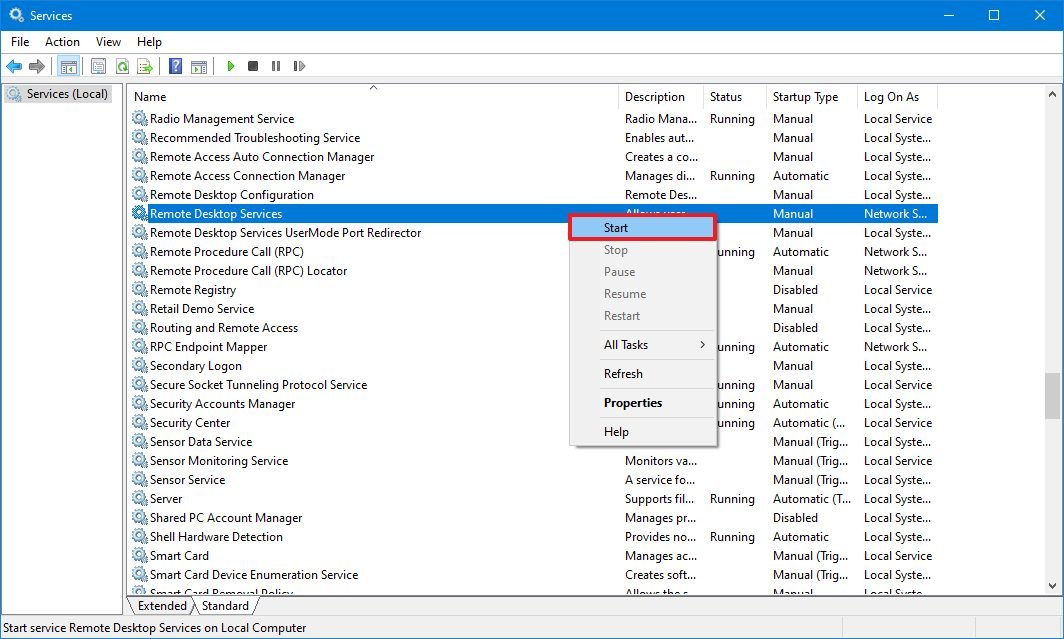 Source: Windows Central
Source: Windows Central
After you complete the steps, you should be able to establish a remote session.
Switch to Internet Protocol Version 4 (TCP/IPv4)
Windows 10 can use both networking stacks, IP version 4 (IPv4) and version 6 (IPv6), but sometimes, it'll choose version 6 for the connection, which may cause problems with the remote desktop protocol (RDP).
To set the IPv4 as the default networking stack on Windows 10, use these steps:
- Open Control Panel.
- Click on Network and Internet.
-
Click on Network and Sharing Center.
 Source: Windows Central
Source: Windows Central -
Click the Change adapter settings option from the left navigation pane.
 Source: Windows Central
Source: Windows Central -
Right-click the active adapter and select the Properties option.
 Source: Windows Central
Source: Windows Central -
Clear the Internet Protocol Version 6 (TCP/IPv6) option.
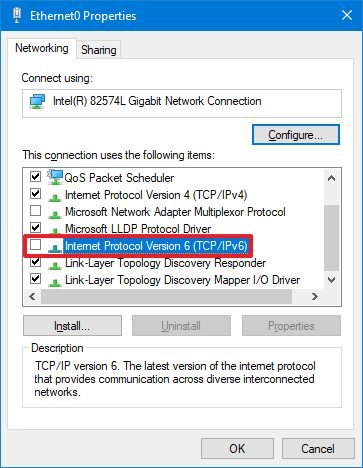 Source: Windows Central
Source: Windows Central - Click the OK button.
- Restart the computer.
Once you complete the steps, you should now be able to connect using a remote connection.
If you still can't establish a remote session, you can try the preview version of the Remote Desktop app (see the above steps) to determine if the problem could be a bug in the stable version of the app.
In this guide, we outlined the steps to connect to a device inside a private network and through the internet, but allowing remote desktop connections (particularly through the internet) could be a security risk.
Always be aware that having remote desktop enabled and opening ports could potentially allow malicious individuals to get unauthorized access to the computer. When using these instructions, use strong a password, and disable the remote desktop service and remove the port forwarding settings on the router when they aren't needed.
We may earn a commission for purchases using our links. Learn more.

Save on Xbox gear
Best Cyber Monday Xbox Series X deals 2021
Stock of the Xbox Series X will still be hard to find on Cyber Monday but there will be plenty of other items on offer. We're expecting big reductions on some top-of-the-line gaming headsets and if you've been looking to upgrade your storage there will be SSD and HDD offers galore. Controllers, Game Pass, and even TVs all feature too.
How To Speed Up Wifi Connection On Pc App
Source: https://www.windowscentral.com/how-use-remove-desktop-app-connect-pc-windows-10-0
Posted by: maclennanwhoods.blogspot.com





























0 Response to "How To Speed Up Wifi Connection On Pc App"
Post a Comment